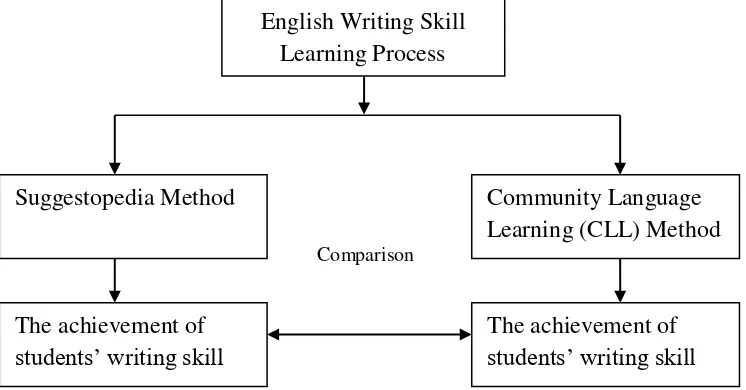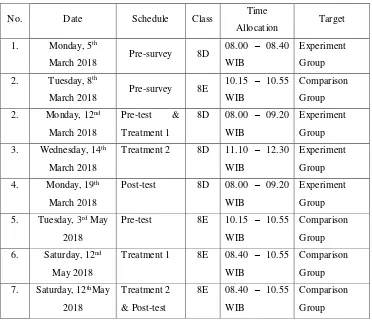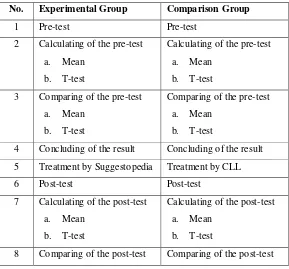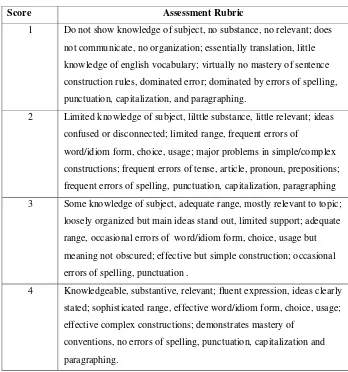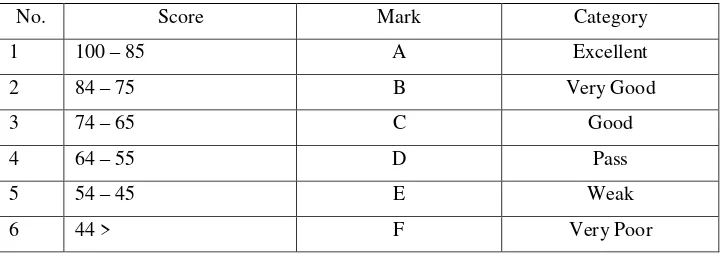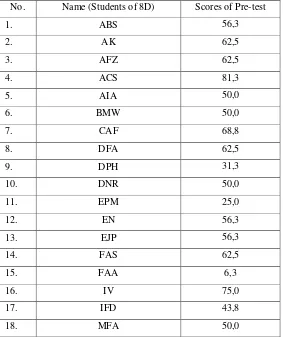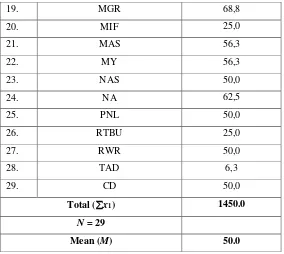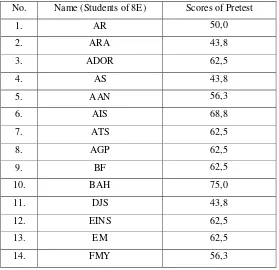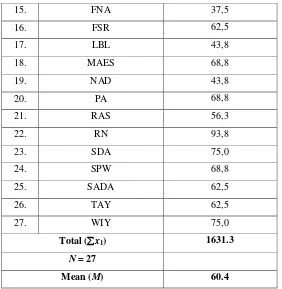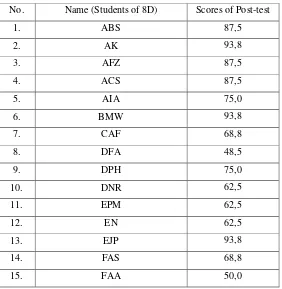i
THE EFFECTIVENESS OF SUGGESTOPEDIA AND COMMUNITY
LANGUAGE LEARNING (CLL) METHODS IN TEACHING WRITING
SKILLS OF RECOUNT TEXT OF THE EIGHTH GRADE STUDENTS
OF SMP NEGERI 10 SALATIGA IN THE ACADEMIC YEAR OF
2017/2018
A GRADUATING PAPER
Submitted to the Board of Examiners as a Partial Fulfillment of the Requirements for the Degree of Sarjana Pendidikan(S.Pd)
By:
LUTHFIYATUS SAIDAH
NIM. 113-14-186
ENGLISH EDUCATION DEPARTEMENT
TEACHING TRAINING AND EDUCATION FACULTY
STATE INSTITUTE FOR ISLAMIC STUDIES (IAIN) OF
ii
v
MOTTO
Good Planning for Good Future
-Mata Air Jepara-
I don’t write to give joy to readers but to give them a conscience
vi
DEDICATION
I proudly dedicate this graduating paper to:
1. My beloved parents Abdul Rosyid and Umi Sholihah, who always love and support of me.
2. My beloved father, Maskuri, who always I miss.
3. My beloved brothers, Khotib Jauhari, M. Ismail and Ahmad Baihaqi. 4. My big family who always support my education.
vii
ACKNOWLEDGEMENT
Bismillahirrahmanirrrahim.
Assalamu’alaikumWr.Wb.
Alhamdulillahirabbil’alamin, all praise to Allah SWT, the Most Gracious and the Most Merciful who always bless and help the writer so the writer can finish the graduating paper. Bless and mercy is upon great Prophet Muhammad SAW for his guidance that leads the writer to the truth.
However, this paper will not be finished without support, advices, help and encouragement from several people institution. Hence, the writer would like to express special thanks to:
1. Mr. Dr. Rahmat Haryadi, M.Pd, the Rector of State Institute for Islamic Studies (IAIN) of Salatiga.
2. Mr. Suwardi, M.Pd, the Dean of Teacher Training and Education Faculty of State Institute for Islamic Studies (IAIN) of Salatiga.
3. Mrs. Noor Malihah, Ph.D, the Head of English Education Department. 4. Mr. Ruwandi, S.Pd, M.A, the counselor of this paper, who gives great
attention, suggestion and guidance for this paper from beginning until the end.
5. All of lectures and staffs of State Institute for Islamic Studies (IAIN) of Salatiga. Especially staffs of IAIN Salatiga’s library (Mr. Wiji Suwarno, Miss Nanin, Mr Supardi, Mr. Maskuri and Mr. Yudan) who always support of me and be a great family.
6. My beloved friends, Anik Saida, Hanik Saida M, Istikomah and Wakhidatul Jannati, who always support me, loving me and always stay with me. 7. My friends all members of TBI 2014. Keep solid and catch your dream,
viii
8. All of my friends of Nurul Asna Islamic Boarding House Pulutan, Salatiga, as being family, friends, partner, teacher, who always support me and have been accompanying me. Especially Setyaning Surya Utami, Riska Dewi, Tri Ismawati, Nurul Fajriyah, Mila, Evi, Awaliya, Cahyati, Khadeeja squad, and AYR.
9. Teachers and students of SMPN 10 Salatiga.
10.Those whom I regret not mention one by one of you. Thanks for your affection and attention.
Salatiga, August 16th 2018 The researcher
ix
ABSTRACT
Saidah, Luthfiyatus. 2018. The Effectiveness of Suggestopedia and Community Language Learning (CLL) Methods in Teaching Writing Skills of Recount Text of the Eight Grade Students of SMP Negeri 10 Salatiga in the Academic Year of 2017/2018. Graduating paper, English Education Department, State Institute for Islamic Studies (IAIN) of Salatiga. Counselor: Ruwandi, S.Pd., M.A.
Keywords: Writing skill, Suggestopedia, Community Language Learning.
The objectives of this study are to find out the different effectiveness and significant effectiveness of students’ writing skills of recount of the eight grade students of SMP Negeri 10 Salatiga in the academic year of 2017/2018. The research data was collected through testing of recount text (pre-test and post-test) and documentation.
The findings of the research showed that there was no different effectiveness of students’ writing skills. It can be seen in the calculation of mean. Mean pre-test of experimental group was 51.641 and comparison group was 60.441 (51.64 < 60.441). While the result of mean post-test of experimental group was 74.270, and mean test of comparison group was 69.467 (74.270 ≥ 69.467). The mean post-test of experimental group was higher than or equal with comparison group. Then there was no significant effectiveness of students’ writing skills. It can be seen in the calculation of t-test. The t-test score of pre-test of experimental group and comparison group were –2.277 and t-table was 2.056. While t-test score of post-test of experimental group and comparison group were 1.120 and t-table score was 2.056. The result showed that t-test score of post-test was lower than t-table (t0 < tt)
from degree of freedom 26 and 95% confidence interval.
x
TABLE OF CONTENTS
TITLE PAGE ... i
DECLARATION ... ii
ATTENTIVE COUNSELOR’S NOTE ... iii
STATEMENT OF CERTIFICATION ... iv
MOTTO ... v
DEDICATION ... vi
ACKNOWLOEDGEMENT ... vii
ABSTRACT ... ix
TABLE OF CONTENTS ... x
LIST OF TABLES ...xv
LIST OF APPENDIXES ... xvii
CHAPTER I: INTRODUCTION A. Background of Study ... 1
B. Statement of the Problem ... 4
C. Objective of the Problem ... 4
D. Benefits of the Problem ... 5
E. Definition of the Keys ... 5
F. Graduating Paper Outline ... 7
CHAPTER II: UNDERLYING THEORIES A. Previous Study ... 8
xi
2. Teaching of Writing... 11
3. Process of Writing ... 12
4. Characteristics of Good Writing ... 13
C. Suggestopedia Method 1. History ... 15
2. Definition ... 15
3. Purposes of Suggestopedia Method ... 17
4. Procedures Suggestopedia in Writing Class ... 17
D. Community Language Learning (CLL) Method 1. History ... 19
2. Definition ... 19
3. Procedures CLL in Writing Class ... 21
4. Advantages and Disadvantages CLL in Writing ... 22
E. Recount Text 1. Definition of Recount ... 23
2. Purpose of Recount ... 23
3. Generic Structure ... 23
4. Significant Lexicogrammatical/Language Features ... 24
F. Minimum Completeness Criteria (KKM)... 24
G. Theoretical Hypothesis ... 25
H. Theoretical Framework... 26
xii
B. Research Approach ... 30
C. Research Method ... 31
D. Population and Sample ... 32
E. Sampling Technique ... 33
F. Research Design ... 33
G. Research Variables ... 35
H. Research Instruments ... 36
I. Data Collecting Method... 36
J. Evaluation Rubric ... 37
K. Evaluation Criteria ... 38
L. Data Analysis ... 39
M. Validity and Reliability ... 41
N. The Procedures of Data Analysis by Using SPSS ... 43
O. Statistical Hypothesis ... 43
CHAPTER IV: RESEARCH FINDINGS AND DATA ANALYSIS A. Research Findings... 45
1. Data Presentation ... 45
a. Pre-test of Both Group ... 45
1) Pre-test Analysis of Experimental Group ... 46
2) Pre-test Analysis of Comparison Group ... 48
b. Post-test of Both Group ... 50
1) Post-test Analysis of Experimental Group ... 51
xiii
2. Validity and Reliability of Test Score ... 55
a. Validity of Pre-test... 55
b. Reliability of Pre-test ... 56
c. Validity of Post-test ... 57
d. Reliability of Post-test ... 59
B. Data Analysis ... 59
1. Paired Mean Pre-test Score... 59
2. Paired Sample Test of Pre-test... 60
3. Paired Mean Post-test Score ... 61
4. Paired Sample Test of Post-test ... 62
C. Discussion ... 63
1. The Result of Mean ... 63
2. The Result of T-count ... 64
CHAPTER V CLOSURE A. Conclusion ... 66
B. Suggestion ... 67
BIBLIOGRAPHY ... 68
xiv
LIST OF TABLES
Table 2.1 Scheme of Theoretical Framework ... 28
Table 3.1 Research Class Schedule ... 31
Table 3.2 Design of Quasi-Experimental Research... 35
Table 3.3 Table of Evaluation Rubric ... 38
Table 3.4 Table of Evaluation Criteria ... 39
Table 4.1 Pre-test Scores of Experimental Group ... 46
Table 4.2 Distribution of Pre-test Score ... 47
Table 4.3 Pre-test Scores of Comparison Group ... 48
Table 4.4 Distribution of Pre-test Score ... 49
Table 4.5 Post-test Scores of Experimental Group... 51
Table 4.6 Distribution of Post-test Score... 52
Table 4.7 Post-test of Comparison Group ... 53
Table 4.8 Distribution of Post-test Score... 55
Table 4.9 Validity of Pre-test ... 55
Table 4.10 Classification of Validity ... 56
Table 4.11 Reliability of Pre-test ... 57
Table 4.12 Reliability ... 57
Table 4.13 Validity of Post-test ... 57
Table 4.14 Classification of Validity ... 58
Table 4.15 Reliability of Post-test ... 58
Table 4.16 Reliability ... 59
Table 4.17 Paired Sample Statistics of Pre-test ... 59
xv
xvi
LIST OF APPENDIXES
1st Appendix Surat Izin Penelitian Skripsi ... 71
2nd Appendix Surat Keterangan Penelitian ... 72
3rd Appendix Syllabus ... 73
4th Appendix Lesson Plans ... 76
5th Appendix Pre-test ...104
6th Appendix Post-test ...109
7thAppendix SPSS’s calculations ...114
8th Appendix T-table ...124
9th Appendix List of SKK ...125
10th Appendix Surat Penunjukkan Pembimbing ...128
11th Appendix Lembar Konsultasi Skripsi ...129
12th Appendix Curriculum Vitae ...131
1
CHAPTER I
INTRODUCTION
A. Background of Study
There are four fundamental language skills which should be mastered by language learners. They are reading, writing, speaking and listening. The students who study the language must master the skills, so they can understand and finish their assignment. Writing is one of the skills which should be taught when learners study the English language. According to Gleb (1969: 11), writing began at the time when man learned how to communicate his thought and feeling by means of the visible sign, understandable not only to himself but also to all other people more or less initiated into the particular system. So, when people want to write something they have to master some vocabulary, understand the structure of writing, and make a sentence that other people understood. Writing is also an activity that changes our thought and feeling into written form and any people can understand what we write.
2
into the English language with appropriate grammar, vocabulary, and content based on the topic.
There are many strategies, methods, and techniques in teaching writing skill. There are two methods that are appropriate to teach writing skill. They are Suggestopedia method and Community Language Learning (CLL) method. According to Asnur (2015: 12), suggestopedia gives positive suggestion to the students that the learning process is easy and fun. While Larsen-Freeman (2000: 89) said that teacher as counselor in CLL method can help the students overcome their negative feelings and turn them into positive energy to further their learning. The writer hopes implementation these methods can give a new experience in teaching-learning process, make comfortable situation in the classroom, and students have meaningful learning. So, the students understand the material and can change or describe their ideas in written text easily to make a good writing result. Suggestopedia method and Community Language Learning (CLL) method focus on suggesting the students to feel enjoy, get more confidence, and change their negative feelings into positive feelings. These methods emphasize new experience in the teaching-learning process.
3
grammar. Lipson and Wixson (2003), cited in Dadi (2015: 4), said that competence of reading and writing in English language learning included: “comprehension, composition, vocabulary development, word
identification and spelling, rate and fluency, grammar, usage and the mechanics of writing”. These problems make students cannot improve their
writing skill. Based on the problem, the writer has to find an appropriate method to teach writing and to improve students’ writing skill, especially in teaching recount text.
According to syllabus KTSP 2006, there are three types of texts are taught in the eighth-grade students that are descriptive, recount and narrative. In this study, the writer focused on recount text in the several aspects that are generic structure, lexicogrammatical/language features and social function in their writing result.
Based on the description above, the writer interested to make an experimental research, because the writer wants to know how far the effectiveness Suggestopedia and Community Language Learning (CLL) methods in teaching writing skill of recount text. The title is “THE EFFECTIVENESS OF SUGGESTOPEDIA AND COMMUNITY LANGUAGE LEARNING (CLL) METHODS IN TEACHING WRITING SKILLS OF RECOUNT TEXT OF THE EIGHTH GRADE STUDENTS OF SMP NEGERI 10 SALATIGA IN THE ACADEMIC YEAR OF 2017/2018”.
4
Based on the background of the study, the problems of this study can be stated as follows:
1. How far is the different effectiveness of students’ writing skills of recount text taught by Suggestopedia method and those taught by Community Language Learning (CLL) method of the eighth grade students of SMP Negeri 10 Salatiga in the academic year of 2017/2018? 2. How far is the significant effectiveness of students’ writing skills of recount text taught by Suggestopedia method and those taught by Community Language Learning (CLL) method of the eighth grade students of SMP Negeri 10 Salatiga in the academic year of 2017/2018?
C. The objective of the Problem
1. To find out the different effectiveness of students’ writing skills of recount text of the eighth grade students of SMP Negeri 10 Salatiga in the academic year of 2017/2018 taught by Suggestopedia method and those taught by Community Language Learning (CLL) method.
2. To find out the significant effectiveness of students’ writing skills of recount text of the eighth grade students of SMP Negeri 10 Salatiga in the academic year of 2017/2018 taught by Suggestopedia method and those taught by Community Language Learning (CLL) method.
D. Benefits of the Study
5
The result of the study can be used as the references for those who want to conduct a study English teaching-learning process. The study can give a new knowledge in teaching a foreign language, especially teaching the English language on writing skill.
2. Practically
a. For the English teacher
The finding out of this study can be a new knowledge for the English teacher in teaching writing. The writer hopes that the English teacher can use the appropriate method to teaching English learning and to improve students’ writing skill.
b. For the students
The finding out of the study could motivate students in to involve them in the learning process actively and to improve their writing skill in teaching-learning process.
E. Definition of the Key Terms
Here are some keys that the writer writes in this paper: 1. Suggestopedia Method
6
designed to counteract the many negative ‘suggestions’ or fears
(Fauziati, 2005: 89).
2. Community Language Learning (CLL) Method
The Community Language Learning Method takes its principles from the more general Counseling-Learning approach developed by Charles A. Curran, who believed that a way to deal with the fears of students is for teachers to become ‘language counselor’. The method
that can help students overcome their negative feelings and turn them into positive energy to further their learning (Larsen-Freeman, 2000: 89).
3. Writing Skill
According to Thresia (2017: 8), writing is a skill which expresses an idea, feeling and thought which are arranged in words, sentences, and paragraph. Writing skills deal with the ability to arrange the graphic such as letters, words, and sentences of a certain language being used in written communication in other that reader can understand the message or information.
4. Recount Text
According to Knapp (2005: 224), cited in Saragih et al. (2014: 57), recount text is written out to inform an event or to entertain people. Recount text is text function as for telling an incident in the past.
7
8
CHAPTER II
UNDERLYING THEORIES
A. Previous Study
The first previous study came from Asriani (2015), graduating paper from Departement of English Education of Syarif Hidayatullah State Islamic University Jakarta entitled the effectiveness of Suggestopedia on students’ reading comprehension. The objective of this study was to find out the empirical evidence whether using Suggestopedia was effective for students on reading comprehension of narrative text at MTsN II Pamulang. The research design in this study is quasi-experimental study using nonequivalent control group design. The data were taken by giving pre-test and post-test reading both of classes. The mean score of pre-test was (53.18) and the post-test was (79.09). The result of the calculation statistical hypothesis test that showed t-value was higher than t-table (2.07 > 1.68). It concluded that there was a significant effect of using Suggestopedia on students’ reading comprehension in the narrative text at the Third Grade
Students of MTsN II Pamulang.
9
are taken from grade III students of Kalam Kudus Elementary School 2 Pematangsiantar. The methodology is used by using action research. The subject is the Grade III Students of Kalam Kudus Elementary School 2 Pematangsiantar. After the data was collected, the researcher concluded recount genre can be applied to improve the writing skill of the students.
The third previous study was taken from graduating paper of English Education Departement of State Institute for Islamic Studies (IAIN) Salatiga by Armala (2015). The aims of this study are the achievement of speaking skill mastery for the first-grade students of SMAN 2 Salatiga and the effectiveness between Community Language Learning and Community Language Teaching to improve the speaking skill of the first-grade students of SMAN 2 Salatiga. The data analysis used in this study is the mean, deviation score, multiplication score, and t-test. The score of the t-test is 0.33 and the t-table score is 1.67. The t-test score in the post-test shows that the t-test is lower than t-table (0.33 < 1.67). Based upon analysis that Community Language Learning and Community Language Teaching is similar or equal. It means that both methods are good to be applied to improve the speaking skill.
Based on the previous study above, there are equal points in the writer’s study, they are Suggestopedia method, Community Language
10
Community Language Learning (CLL) method in the teaching-learning process and recount genre to improve students’ writing skill. So, the writer
uses Suggestopedia method to compare with Community Language Learning (CLL) method in teaching writing skill of recount text and hopes one of the methods can improve students’ writing skill, especially on recount text. As the result, the writer’s study is different from the previous study.
B. Writing Skills
1. Definition of Writing
Writing is one of the four language skill beside listening, speaking and reading. Writing is an activity that changes our thought and feeling into the written form. According to Gleb (1969: 11), writing began at the time when man learned how to communicate his thought and feeling by means of a visible sign, understandable not only to himself but also to all person more or less initiated into the particular system.
Thresia (2017: 8) said that writing is a skill which expresses an idea, feeling, thought which are arranged in words, sentences, and paragraph. Writing is basically the process of expressing ideas and thought of the writer using knowledge of structure and vocabulary to combine the writer’s ideas as a means of communication.
11
appropriate structure, understandable to other, and the purpose to communicate to other.
2. Teaching of Writing
According to Harmer (2001: 79), the reasons for teaching writing to students of English as a foreign language include reinforcement, language development, learning style, and writing as a skill.
a. Reinforcement
The visual demonstration of language construction is invaluable for both of us understanding of how it all fits together and as an aid to committing the new language to memory. Students often find it useful to write sentences using new language shortly after they have studied it.
b. Language Development
The actual process of writing helps us to learn as we go along. The mental activity we have to go through in order to construct proper written texts is all parts of the ongoing learning experience.
c. Learning Style
12 d. Writing as Skill
The most important reason for teaching writing, because is that it is a basic language skill, just as important as speaking, listening and reading. Students need to know how to write a letter, how to put written reports together, how to reply to the advertisement. They need to know some of the writing’s special conventions
(punctuation, paragraph construction etc.) just as they need to know how to pronounce spoken English appropriately.
3. Process of Writing
According to Dadi (2015: 52), the process of writing consists of five stages. They are planning, drafting/revising, editing/proofreading, final draft, and follow up.
a. Planning
A writer should think about what the reader will disclose and record the essence of the paper to be discussed.
b. Drafting/revising
13 c. Editing/proofreading
This stage deals with ideas, an organization of writing, vocabulary, spelling, grammar, and the procedure of writing in English.
d. Final draft
After editing and made some necessary improvements, a final draft is made. In this stage, the final draft can be very different from the first draft. And writing at this stage is readily presented to the reader. e. Follow up
After being presented to the reader, there may be various inputs so that the paper will be refined as needed.
4. Characteristics of Good Writing
According to Heaton (1990: 135), the following analysis attempts to group the many and varied skills necessary for writing good prose into five general components or main areas.
a. Language use
Language use is the ability to write correct and appropriate sentences.
b. Mechanical skill
14 c. Treatment of content
Treatment of content is the ability to think creatively and develop thoughts, excluding all irrelevant information.
d. Stylistic skills
Stylistic skills are the ability to manipulate sentences and paragraphs, and use language effectively.
e. Judgment skills
Judgment skills are the ability to write in an appropriate manner for a particular purpose with a particular audience in mind, together with an ability to select, organize and order relevant information.
According to Dadi (2015: 125), when we write an English text, there are other important things to noticed, they are unity and coherence.
a. Unity
A paragraph must have unity of ideas and be said to have untiy, if all of sentences discuss only one idea. All of sentences in paragraph have support topic sentence and controlling idea, and all of sentence relevent to topic sentence.
b. Coherence
15
Its means that when we write and want to make a good writing, we must give attention to five components in writing above and the sentence with other has unity and coherence. Because these components make the reader understand and know what our ideas.
C. Suggestopedia Method
1. History
According to Stevick (1976: 42), cited in Fauziati (2005: 89), Suggestopedia is a method of teaching developed by Georgi Lazanov, a Bulgarian psychiatrist educator. It first started purely as a psychological experiment aimed at increasing memory capacities in the educational process.
Based on Asnur (2015: 12), Suggestopedia is used in different fields, but mostly in the field of foreign language learning. The theory applied positive suggestion in teaching when it was developed in 1970s. However, as the method improved, it has focused more on “desuggestive learning” and now is often called “desuggestopedia”.
Suggestopedia is a portmanteau of the words “suggestion” and “pedagogy”. A common misconception is to link “suggestion” to “hypnosis”.
2. Definition
16
systematic study of the notational and/or conscious influence that human beings are constantly responding to. This methodology is designed to counteract the many negative ‘suggestions’ or fears (Fauziati, 2005:
89).
Suggesti is a communicative factor used to suggest that other people make choice in a rational and intuitive in accordance with their respective personalities in learning another language. Larsen-Freeman states that Suggestopedia is the application of the study of suggestion to pedagogy, has been developed to help students eliminate the feeling that they cannot be successful of the negative association they may have toward studying and, thus to help them overcome the barriers to learning (Asnur, 2015: 12).
Thus, it can be concluded that Suggestopedia is a teaching-learning method of foreign language that give suggestion positive think to the students. Suggestopedia gives positive suggestion to feel relax and enjoy in the learning process of foreign language.
17
characteristics of Suggestopedia method is the use of music. Music and rhythm are central to learning. The use of music helps the students relax and feel the learning experience is going to be a pleasant one (Fauziati, 2005: 89). Music in the learning process background helps to make students focus and concentrate to the material (Deny, 2016: 131).
3. Purposes of Suggestopedia Method
Suggestopedia method aims to make the students feel enjoy, relax and more concentrate in teaching-learning process and to counteract any negative suggestions. So, the students feel more enjoy, confidence, concentrate, understand material easily, and they think that learning foreign language especially English language is fun.
Based on Dwimarta (2016: 271), Suggestopedia methods provide a lots of fun while learning that students will understand easily the material that being taught, as Wicaksono and Roza (2015: 78) explained 1) give tranquility and relaxation, 2) pleasant or uplifting, 3) speed up the learning process, 4) emphasis with development of proficiency that create an comfortable atmosphere of apprenticeship of writing skill by giving positive suggestion from the teachers and through songs to stimulate the imagination of the students.
4. Procedures Suggestopedia in Writing Class
18
use of music which one of key features of Suggestopedia method can stimulate the students to appear their imagination about something or what they want to write, so they can do it easily.
The researcher designs the class based on the principle of suggestopedia. These are procedures of Suggesopedia method in writing class.
a. The teacher greets the students in their native language and foreign language. The teacher tells the students that they are about to begin a new and exciting experience in language learning. The teacher say it in the confident way.
b. The teacher plays music, instrument music to built positive environment and suggestion. This music purposes to make students feel enjoy, cheerful and less the students’ fear.
c. The teacher reads the material with instrument music played. Then, the teacher explains to the students about the recount text such as the kind of text, purpose of the text, the organization, the grammar use. d. After that, the teacher plays the game with instrument music played. Rule the game is the students take the color piece of paper and read the vocabulary in the paper. One student gets one vocabulary (verb 1). After they get the paper, they write a sentence (past tense) use the vocabulary that they get. Then, the students read it.
19
D. Community Language Learning (CLL) Method
1. History
According to Richards and Rodgers (2007: 113), Community Language Learning (CLL) is the name of a method developed by Charles A. Curran and his associates. He was a specialist in counseling and a professor of psychology. His application of psychological counseling techniques to learning is known as Counseling-Learning. Community Language Learning represents the use of Counseling-Learning theory to teach language.
In the Community Language Learning (CLL) method, Curren believed that a way to deal with the fears of students is for teachers to become ‘language counselors’. A language counselor does not mean
someone trained in psychology, it means someone who is a skillful understander of the struggle students face as they attempt to internalize another language (Larsen-Freeman, 2000: 89).
2. Definition
Community Language Learning draws on the counseling metaphor to redefine the roles of the teacher (the counselor) and the learners (the
20
teacher who can ‘understand’ can indicate his acceptance of the student. By understanding students’ fears and being sensitive to them, he can
help students overcome their negative feelings and turn them into positive energy to further their learning (Larsen-Freeman, 2000: 89).
Thus, it can be concluded that Community Language Learning (CLL) is a language teaching method that uses Counseling-Learning theory to teach language that helps students to change their negative feeling into positive feeling and helps the students try to understand his or her problems better by applying order and analysis to them. So, the students feel relax and confident in the learning-teaching process , and use the target language.
The Community Language Learning (CLL) procedures are a group of learners sit in a circle with the teacher standing outside the circle, a student whispers a message in the native language (L1) and the teacher translates it into the foreign language (L2) (Richards and Rodgers, 2007: 113). The primary characteristics of the Community Language Learning is the feeling of trust among members of the group, resulting in a mutual and open exchange of ideas (Fauziati, 2005: 57).
3. Procedures CLL in Writing Class
21
a. The teacher greets students in their native language and foreign language. The students’ native language is used to make the meaning
clear and to build a bridge from the known to the unknown. b. The teacher tells the students what they are going to do.
c. The teacher divides the class to some groups, which each group with 4-5 students. This way aims to make students feel enjoy and lees students’ fear. In group, students can begin to feel a sense of
community and can learn from each other as well as the teacher. d. Then, the teacher explains to the students about the recount text such
as the kind of text, purpose of text, the organization, the grammar use. The teacher reads recount text, and translates it into native language.
e. The teacher asks to the students to write one vocabulary (verb 1) that they think in native language. Then, the teacher helps the students translate their vocabulary.
f. Next, the teacher asks to the students to make a sentence (past tense) use their vocabulary and combines with other students in the group into one paragraph recount.
g. In the end of the class there is no homework for the students.
4. Advantages and Disadvantage CLL in Writing
According to Gunawan (2018: 74), there are some advantages and disadvantages CLL in writing.
22
1) CLL is an attempt to overcome the threatening affective factors in EFL and ESL.
2) The counselor allow the learners to determine type of conversation and to analyze the language inductively.
3) The students centered nature of the method can provide extrinsic motivation and capitalize on intrinsic motivation.
b. Disadvantages of CLL in writing
1) The counselor/teacher can become too non directive. Students often need directions.
2) The method relies completely on inductive learning. It is worthwhile noting that deductive learning is also a viable strategy of learning.
23
E. Recount Text
1. Definition of recount
Accroding to Knapp (2005: 224), cited in Saragih (2014: 57), said that recount text basically it is written out to make a report about an experience of a series of related event. Recount text is text function as for telling an incident in the past.
2. Purpose of recount
The purpose of recount text is informing or entertaining the reader about an accident in the past. Its means that recount text aims to tells the reader about what and when the accidents happens.
3. Generic Structure
There are three steps for constructing a recount text, they are: a. Orientation
It is located in the first paragraph that provides the setting and introduces participants. This step introduces about background and give information about who, what, where and when.
b. Events
This step located in middle paragraph and tells what happened, in what sequence.
c. Re-orientation
24
4. Significant Lexicogrammatical/Language Features
According to Boardman (2008: 287), cited in Saragih (2014: 57), there are the language features usually found in a recount:
a. Use of nouns and pronouns to identify people, animal or things involved.
b. Use of past action verbs to refer the events.
c. Use of past tense to located events in relation to speakers’ or researcher’s time.
d. Use of conjunctions and time connective to sequence the event.
e. Use of adverb and adverbial phrases to indicate place and time.
f. Use of adjectives to describe nouns.
F. Minimum Completeness Criteria (KKM)
According to Mardapi (2015: 40), Minimum Completeness Criteria (KKM) is also called the pass limit or standard setting. Standard can be interpreted as an agreed benchmark, and standard setting is the process of determining cut score of educational instruments.
According to Asmuni (2010: 197), every subject are based on the following criteria, there are explained as follow:
25
2. Minimum Completeness Criteria (KKM) is determined by MGMP (Musyawarah Guru Mata Pelajaran) depend on school institution. 3. It showed in scoring number from about 0-100.
4. School institution determined a Minimum Completeness Criteria (KKM) under completeness study maximum.
Based on the researcher’s survey, minimum completeness criteria
(KKM) at SMP Negeri 10 Salatiga their standard is 75.
G. Theoretical Hypothesis (Ha)
Hypothesis is the truth that is still below (not necessarily true) and can be a truth if it is accompanied by evidence. The research of two or more variables, the hypothesis is a conjecture about the truth about the relationship of two or more variables (Arikunto, 2016: 45).
Based on the statement above, the researcher can take hypothesis: 1. There is no the different effectiveness of students’ writing skills of
recount text taught by Suggestopedia method and those taught by Community Language Learning (CLL) method.
26
H. Theoretical Framework
According to Soemanto (1990: 99), learning is a process, and not a result. Learning takes place actively and integratively by using various of actions to achieve a goal.Learning is directed at achieving goals and appearing motivation to achieve the goal.
Giving motivation to the students is one of ways to achieving the goal. It means providing an instruction that can explain the direction of learning activities that are the basic needs of students.
Based on the above explanation, the author decided to use two methods based on theory counseling. The two methods are Suggestopedia method and a Community Language Learning method that helps motivate students and alter negative feeling (fear, confusion) into positive feeling in learning.
In this research, the researcher makes the scheme of theoretical framework. The scheme explains that to improve students’ writing skill of
27
Table 2.1 Scheme of Theoretical Framework
Comparison
English Writing Skill Learning Process
Community Language Learning (CLL) Method Suggestopedia Method
The achievement of students’ writing skill
28
CHAPTER III
METHODOLOGY OF RESEARCH
A. Research Setting
1. Research Time and Setting
The research is carried out in SMP Negeri 10 Salatiga which located at Jalan Argoboga Salatiga.
2. School Profile
Name of School : SMP Negeri 10 Salatiga Status : State School
Established : 1995
Address : Argoboga Street, Randuacir District : Argomulyo
Regency : Salatiga Province : Central Java Postal Code : 50735
Phone Number : (0298) 328173
29
3. Vision and Mission of SMP Negeri 10 Salatiga
Vision
“Mewujudkan manusia seutuhnya yang bertaqwa, berakhla mulia,
terampil, cerdas, berwawasan iptek, berwawasan kebangsaan dan lingkungan hidup.”
Mission
a. Menciptakan kegiatan belajar mengajar yang PAKEM, menantang, menyenangkan, komunikatif, tanpa takut salah dan demokratis. b. Meraih prestasi yang lebih baik di bidang akademik dan
non-akademik.
c. Merealisasikan penghayatan dan pengamalan agama, kaimanan dan ketakwaan, mengembangkan sikap dan perilaku religiusitas di lingkungan dalam dan luar sekolah sesuai dengan keyakinan agamanya masing-masing.
d. Mengembangkan budaya gemar membaca, rasa ingin tahu, bertoleransi, bekerja sama, saling menghargai, disiplin, jujur, kerja keras, kreatif, dan mandiri, serta memupuk disiplin belajar dan mengajar secara kontinu dan kesinambungan.
e. Menanamkan kepedualian sosial dan lingkungan, cinta damai, cinta tanah air, semangat kebangsaan, dan hidup demokratik. f. Menciptakan suasana kerja dengan iklim kekluargaan, persatuan,
kesatuan warga sekolah dengan prinsip asah, asih, asuh.
30
Table 3.1 Research Class Schedule
No. Date Schedule Class Time
31
A quasi-experimental research aims to reveal the causal relationship by involving experimental group and control or comparison group, but the separation of both groups was not by random technique. Based on Muijs (2004: 27), quasi-experimental research are not using random allocation, call this control group the comparison group as it is not a pure control group. In this research, the researcher wants to know how far the effectiveness of Suggestopedia and Community Language Learning (CLL) methods in teaching writing skills of recount text of the eighth grade students of SMP Negeri 10 Salatiga in the academic year of 2017/2018.
C. Research Method
32
D. Population and Sample
1. Population
According to Sugiyono (2017: 117), population is a generalization region consisting of object or subjects that have certain qualities and characteristics set by the researchers to be studied and then drawn conclusions. Furthermore Arikunto (1998: 115), population is the whole subjects of research. The writer will take population in the eighth grade students of SMP Negeri 10 Salatiga in the academic year of 2017/2 018 which consists of 8 classes and 219 students.
2. Sample
33
E. Sampling Technique
Technique of sampling is a technique to get sample. To determine the sample to be used in the study, there are various sampling techniques used. They are probability sampling and nonprobability sampling. Probability sampling included simple random sampling, proportionate stratified random sampling, disproportionate stratified random sampling and area (cluster) sampling. Then, nonprobability sampling included systematic sampling, quota sampling, incidental sampling, purposive sampling, saturated sampling and snowball sampling (Sugiyono, 2017: 118-119).
This research used purposive sampling to chosen the sample. According to Supriyadi (2014: 22), purposive sampling is a technique of determining the sample with special consideration so it deserves to be sample. Among 8 classes of the eighth grade students, two classes were selected based on the students’ score achievement from the middle term
examination to decide an experimental group or comparison group. Then, VIII D was as the experimental class and VIII E was as the comparison class.
F. Research Design
In this research, the research used Pretest-Posttest Control Group Design to find out that significant difference of students’ writing skill the
34
treatment CLL method, and the significant effectiveness Suggestopedia method and Community Language Learning (CLL) method in teaching writing skill. Then, the researcher will choose two classes to be the experimental group and comparison group. The experimental group will give pre-test, a treatment by Suggestopedia method and post-test. Then the comparison group will give pre-test, treatment by CLL method and post-test. This study uses pre-test and post-test to know significant difference students’ writing skill of students receives treatment Suggestopedia method
and Community Language Learning (CLL) method, and to see the significant effectiveness of Suggestopedia method and Community Language Learning (CLL) method in teaching writing skills. The researcher serves the designed table as follows:
Table 3.2 Design of Quasi-Experimental Research
No. Experimental Group Comparison Group
1 Pre-test Pre-test
2 Calculating of the pre-test
a. Mean
b. T-test
Calculating of the pre-test
a. Mean
b. T-test
3 Comparing of the pre-test
a. Mean
b. T-test
Comparing of the pre-test
a. Mean
b. T-test
4 Concluding of the result Concluding of the result
5 Treatment by Suggestopedia Treatment by CLL
6 Post-test Post-test
7 Calculating of the post-test
a. Mean
b. T-test
Calculating of the post-test
a. Mean
b. T-test
35
a. Mean
b. T-test
a. Mean
b. T-test
9 Concluding of the result Concluding of the result
G. Research Variables
According to Arikunto (1998: 99), variable is the object of research, or what the point of attention of a research. Creswell (2015: 77) said that there are some variable in the quantitative research. They are:
1. Independent Variable
Independent variables in experimental research is also frequently referred to as the experimental, or treatment, variable. Independent variable frequently manipulated in educational research include methods of instruction, types of assignment, learning materials, rewards given to students, and types of questions asked by teachers (Frankel & Norman, 2009: 261).
2. Dependent Variable
Dependent variables, also known as the criterion, or outcome, variable refer to the result or outcomes of the study. Dependent variables that are frequently studied include achievement, interest in a subject, attention spam, motivation, and attitudes toward school (Frankel & Norman, 2009: 261).
36
dependent variable is writing skills of recount text of the eighth grade students of SMP Negeri 10 Salatiga in the academic year of 2017/2018.
H. Research Instruments
According to Arikunto (1998: 137), instrument is a tool used by a researcher in using a method. Instrument is used to collect data and divided into two kinds. There are test and non-test. The test consists pre-test and post-test, while the non-test is documentation. In this research, the researcher applied written test and documented the students’ test sheets,
lesson plan, recount text sheets, syllabus, and photos reports.
I. Data Collecting Method
Data collecting method is a way of obtaining data in a research. In this research, the writer collected data from documentation and test.
1. Documentation
Documentation techniques are techniques about finding data about things or variables in the form of notes, transcripts, books, newspapers, magazines, inscriptions, minutes, meetings, agenda etc. (Arikunto, 1998: 236). In this research, the researcher documented the students’ test sheets, lesson plan, recount text sheets, syllabus,
37 2. Test
Tests are a series of questions or exercises or other tools used to measure the skills, knowledge, intelligence, abilities or talents possessed by individuals or groups (Arikunto, 1998: 139). In the experimental research there are two kinds of tests. They are:
a. Pre-test
Pre-test is test that give in the beginning class. The test that given before treatment, and has purpose to know the equivalentof the experimental class and the comparison class before the implementation of treatment.
b. Post-test
Post-test is test that give after the implementation of treatment. The purpose is to see if there any difference significant between experimental class and comparison class.
J. Evaluation Rubric
38
Based on definition above, evaluation rubric is a scoring guide to evaluate the quality of students in the teaching-learning process.
Based on Heaton (1990: 146), the students’ ability in writing can be
measured. It can be seen as follows:
Table 3.3 Table of Evaluation Rubric
Score Assessment Rubric
1 Do not show knowledge of subject, no substance, no relevant; does
not communicate, no organization; essentially translation, little
knowledge of english vocabulary; virtually no mastery of sentence
construction rules, dominated error; dominated by errors of spelling,
punctuation, capitalization, and paragraphing.
2 Limited knowledge of subject, lilttle substance, little relevant; ideas
confused or disconnected; limited range, frequent errors of
word/idiom form, choice, usage; major problems in simple/complex
constructions; frequent errors of tense, article, pronoun, prepositions;
frequent errors of spelling, punctuation, capitalization, paragraphing
3 Some knowledge of subject, adequate range, mostly relevant to topic;
loosely organized but main ideas stand out, limited support; adequate
range, occasional errors of word/idiom form, choice, usage but
meaning not obscured; effective but simple construction; occasional
errors of spelling, punctuation .
4 Knowledgeable, substantive, relevant; fluent expression, ideas clearly
stated; sophisticated range, effective word/idiom form, choice, usage;
effective complex constructions; demonstrates mastery of
conventions, no errors of spelling, punctuation, capitalization and
paragraphing.
K. Evaluation Criteria
39
Table 3.4 Table of Evaluation Criteria
No. Score Mark Category
After the writer collects the data, the next step of this study analyzes the data. The data is the score of test. In analyzing the test score of writing, the writer used t-test to find out significant difference effectiveness before and after the treatment for the experimental and comparison class. To analyze the data in this research, the researcher firstly calculated the mean of pre-test and post-test of the experimental class and comparison class. The formula based on Sudijono (2010: 317):
1. Mean (M)
fa : pre-test score of experimental class
40 N : Total number of the students 2. Deviation
xa = fa – Ma
xb = fb – Mb
Notes:
xa : deviation the individual score
xb : deviation the individual score
3. Score xa2 and xb2
xa2 = xa × xa
xb2 = xb × xb
Notes:
xa2 : multiplication of deviation
xb2 : multiplication of deviation
4. T-test (t0)
t0 = 𝑀𝑎−𝑀𝑏
√(𝑁𝑎+𝑁𝑏−2𝑥𝑎2+ 𝑥𝑏2)(𝑁𝑎+𝑁𝑏𝑁𝑎 . 𝑁𝑏)
Notes:
M : mean of pre-test
N : total number of students xa2 : multiplication of deviation
41
M.Validity and Reliability
1. Validity
According to Frankel & Norman (2009: 147), validity is the most important idea to consider when preparing or selecting an instrument for use. More than anything else, researchers want the information they obtain through the use of an instrument to serve their purposes.
In this research, researcher used such kinds of validity: a. Content-related evidence of validity
Content validation, therefore, is partly a matter of determining if the content that the instrument contains is an adequate sample of the domain of content it is supposed to represent.
42
b. Criterion-related evidence of validity
A criterion is a second test or other assessment procedure presumed to measure the same variable (Frankel & Norman, 2009: 152). In this research, there is a pre-test and post-test.
c. Construct-related evidence of validity
Construct-related evidence of validity is the broadest of the three categories of evidence for validity that we are considering (Frankel & Norman, 2009: 153). In this research, researcher used tests with the indicator of KTSP.
2. Reliability
Reliability refers to the consistency of the scores obtained, how consistent they are for each individual from one administration of an instrument to another and from one set of items to another (Frankel & Norman, 2009: 154).
Another check on the internal consistency of an instrument is to calculate an alpha coefficient or usually called Cronbach alpha. This coefficient (α) is a general form of the KR20 formula to be used in
43
N. The Procedures of Data Analysis by Using SPSS
The method of analysis that used to test hypotheses was through the Statistical Product and Service Solution (SPSS) version 18.0 to calculate Paired Sample T Test.
To analyze the data, the researcher applied the calculation data to find out the result Paired Sample T Test using SPSS 18. Here is the explanation:
1. Open the worksheet of SPSS, click the varibale view;
2. Input the four name of variables (pre-test of Suggestopedia as ‘SG’, post-test Suggestopedia as ‘SG2’, pre-test CLL as ‘CLL’, and post-test CLL as ‘CLL2’), click the data view;
3. Input the students’ score based on the variables;
4. Click analyze – compare means – paired sample t-test; 5. A dialogue of paired sample t-test will pop up;
6. Put SG on the variable 1 and CLL on the variable2, then click ok; 7. Then, SG2 on the variable 1 and CLL2 in the variable 2, click ok; 8. The result of paired sample t-test cold be seen on output SPSS; 9. Finally exported output SPSS into word (doc).
O. Statistical Hypothesis
H01 : There is the different effectiveness of students’ writing skills of
44
H02 : There is the significant effectiveness of students’ writing skills of
45
CHAPTER IV
RESEARCH FINDINGS AND DATA ANALYSIS
A. Research Findings
1. Data presentation
In this section, the writer will present the data of the research taken along the pre-test and post-test.
a. Pre-test of Both Group
The pre-test was conducted before treatment to measure the students’ writing skills before treatment namely by Suggestopedia
for experimental group and Community Language Learning (CLL) for comparison group.
The pre-test students were asked to arrange the picture and made a simple sentence based on the picture and instruction given the scoring of pre-test was each picture accompanied by a sentence was scored 4 (four). If the students were able to make good sentence for each picture, they would get 16 (maximum score), so the total score was 100. The use of picture on the pre-test questions based on suggestopedia’s theory about the characteristics of suggestopedia by
Richard & Theodore (2007).
46 Total Score = 𝐴𝑐𝑞𝑢𝑖𝑟𝑒𝑑 𝑆𝑐𝑜𝑟𝑒
𝑀𝑎𝑥𝑖𝑚𝑢𝑚 𝑆𝑐𝑜𝑟𝑒
× 100
Furthermore, these are the pre-test scores of experimental group and comparison group.
1) Pre-test Analysis of Experimental Group
The pre-test of experimental group was held on March, 12nd
2018 at 8D of SMP Negeri 10 Salatiga. The treatment which would be given was Suggestopedia. After the pre-test was done, the researcher checked and gave score for the test. The result of the pre-test of the experimental group was as follows:
Table 4.1 Pre-test Score of Experimental Group
No. Name (Students of 8D) Scores of Pre-test
47 pre-test. The highest score of the experimental group was 81.3 and the lowest score was 6.3. The mean of the experimental group was 50.
The distribution of the pre-test scores of the experimental group can be seen in the following table.
Table 4.2 Distribution of Pre-test Scores
No. Score Category Frequency
48
The table result 4.2 showed that all students had done the Pre-test by various different categories. By the total 29 students, 7 (seven) students obtained very poor category and 8 (eight) students obtained weak category, and 10 (ten) students obtained pass category. Then, there were 2 (two) students obtained good category and 2 (two) students obtained very good category.
2) Pre-test Analysis of Comparison Group
The pre-test of comparison group was held on May, 3rd 2018 at 8E of SMP Negeri 10 Salatiga. They would be taught using Community Language Learning (CLL). The result of the pre-test scores of the comparison group was as follows:
Table 4.3 Pre-test Scores of Comparison Group
No. Name (Students of 8E) Scores of Pretest
49
Based on the table 4.3, there were 27 students had done the pre-test. The highest score of the comparison group was 93.8 and the lowest score was 37.5. The mean of the comparison group was 60.4.
The distribution of the pre-test score of the comparison group can be seen in the following table.
Table 4.4 Distribution of Pre-test Score
No. Score Category Frequency
50
The table result 4.4 showed that all students had done the Pre-test by various different categories. By the total 27 students, 5 (five) students obtained very poor category and 1 (one) students obtained weak category, and 11 (eleven) students obtained pass category. Then, there were 4 (four) students obtained good category and 5 (five) students obtained very good category. At last, there was 1 (one) student obtained excellent category.
b. Post-test of Both Group
The post-test was conducted after the treatment to measure the students’ writing skills namely by Suggestopedia for
experimental group and Community Language Learning (CLL) for comparison group.
In the post-test, students were asked to make a simple sentence based on cue words and instruction. The scoring of pre-test was each sentence that used cue words scored 4 (four) if the students were able to make good sentence get 16 (maximum score) and total score was 100 score. The use of cue words on the post-test, it based on suggetopedia’s theory of suggestopedia by Richards & Theodore.
51
To make a guideline on correcting question, the researcher arranged the formula:
Total Score = 𝐴𝑐𝑞𝑢𝑖𝑟𝑒𝑑 𝑆𝑐𝑜𝑟𝑒
𝑀𝑎𝑥𝑖𝑚𝑢𝑚 𝑆𝑐𝑜𝑟𝑒
× 100
Furthermore, these are the post-test scores of experimental group and comparison group.
1) Post-test Analysis of Experimental Group
The post-test of experimental group was held on March, 19th 2018 at 8D of SMP Negeri 10 Salatiga after they were taught by Suggestopedia. After the post-test was done, the researcher checked and gave score for the test. The result of the post-test of the experimental group was as follows:
Table 4.5 Post-test Scores of Experimental Group
No. Name (Students of 8D) Scores of Post-test
52
Based on the table 4.5, there were 29 students had done the pre-test. The highest score of the experimental group was 93.8 and the lowest score was 37.5. The mean of experimental group was 73.7.
The distribution of the pot-test score of the experimental group can be seen in the following table.
Table 4.6 Distribution of Post-test Score
No. Score Category Frequency
1 100 – 85 Excellent 11
2 84 – 75 Very Good 4
3 74 – 65 Good 4
4 64 – 55 Pass 5
53
6 44 > Very Poor 1
Total N = 29
The table 4.6 showed that all students had done the Post-test by various different categories. By the total 29 students, 1(one) students obtained very poor category, 4 (four) students obtained weak category, and 5 (five) students obtained pass category. Then, 4 (four) students and 4 (four) students obtained good category and very good category. At last, there was 11 (eleven) students obtained excellent category.
2) Post-test Analysis of Comparison Group
The post-test of comparative group was held on May, 12nd 2018 at 8E of SMP Negeri 10 Salatiga after they were taught by Community Language Learning (CLL). The result of the post-test of the comparison group was as follows:
Table 4.7 Interpretation of Post-test Score
No. Name (Students of 8E) Scores of Post-test
54
Based on the table 4.7, there were 27 students had done the pre-test. The highest score of the comparison group was 100 and the lowest score was 37.5. The mean of the comparison group was 69.4.
55
Table 4.8 Distribution of Post-test Score
No. Score Category Frequency
1 100 – 85 Excellent 4
2 84 – 75 Very Good 5
3 74 – 65 Good 8
4 64 – 55 Pass 6
5 54 – 45 Weak 3
6 44 > Very Poor 1
Total N = 27
56
2. Validity and Reliability of Test Score
a. Validity of Pretest Score
Table 4.9 Validity of Pretest
Correlations
**. Correlation is significant at the 0.01 level (2-tailed).
Based on table 4.9, the table showed that r-count 1st item was 0.517, 2nd item was 0.666, 3rd item was 0.815, and 4th item was 0.792. The total’s item was 0.792. According to Guilford (1956:
57
Table 4.10 Classification of Validity
Pearson Correlation Category
0.80 – 1.00 Very valid
0.60 – 0.80 More valid
0.40 – 0.60 Valid
0.20 – 0.40 Less valid 0.00 – 0.20 Very poor valid b. Reliability of Pre-test
Table 4.11 Reliability of Pre-test
Reliability Statistics Cronbach's
Alpha N of Items
,669 4
Based on the table 4.11 showed that croncbach’s alpha was 0.669. According to Guilford (1956: 145) in cited Guntur (2018), when Cronbach’s alpha was 0.669 it means that the test scores were
more stable.
Table 4.12 Reliability
Score Cronbach’s alpha Category
0.80 < α ≤ 1.00 Very stable
0.60 < α ≤ 0.80 More stable
0.40 < α ≤ 0.60 Stable
0.20 < α ≤ 0.40 Less stable
58 c. Validity of Post-test
Table 4.13 Validity of Post-test
Correlations
**. Correlation is significant at the 0.01 level (2-tailed).
Based on the table 4.13, the table showed that 1st items was 0.504, 2nd items was 0.428, 3rd items was 0.699, and 4th items were 0.636. The total’s item was 0.636. According to Guilford (1956:
59
Table 4.14 Classification of Validity Pearson Correlation Category
0.80 – 1.00 Very valid
0.60 – 0.80 More valid
0.40 – 0.60 Valid
0.20 – 0.40 Less valid 0.00 – 0.20 Very poor valid
d. Reliability of Post-test
Table 4.15 Reliability of Post-test
Based on the table 4.15 showed that croncbach’s alpha was
0.365. According to Guilford (1956: 145) in cited Guntur (2018), when Cronbach’s alpha was 0.365 it means that the test scores were less stable.
Table 4.16 Table Reliability
Score Cronbach’s alpha Category
0.80 < α ≤ 1.00 Very stable
0.60 < α ≤ 0.80 More stable
0.40 < α ≤ 0.60 Stable
0.20 < α ≤ 0.40 Less stable
α < 0.20 Very poor stable
Reliability Statistics
Cronbach's
Alpha N of Items
60
B. Data Analysis
1. Paired Mean Pre-test Score
Table 4.17 Paired Sample Statistics
Paired Samples Statistics
Mean N Std. Deviation Std. Error Mean
Pair 1 SGG 51.641 27 16.8607 3.2449
CLL 60.441 27 12.6152 2.4278
Based on table 4.17 showed that the mean of the experimental group was 51.641 with the standard deviation 16.8607 and standard error mean was 3.2449. Then, the comparison group was 60.441 with standard deviation 12.6152 and standard error was 2.4278. It means that mean of the experimental group was lower than the comparison group (51.642 < 60.441).
2. Paired Sample Test
Table 4.18 Paired Sample Tests of Pre-test Score
61
Based on table 4.18, the t-table was found to be 2.056 (level significance: 0.05, df: 26), two tailed of test. The t-count was compared to the t-table. The t-count was smaller than t-table (-2.277 < 2.056). The conclusion was that Ha was accepted and H0 was
rejected. In other words, there was no significant effectiveness in pre-test average score students’ writing skill before treatment (Suggestopedia and CLL).
3. Paired Mean Post-test Score
Table 4.19 Paired Sample Statistics
Paired Samples Statistics
Mean N Std. Deviation Std. Error Mean
Pair 1 SGG2 74.270 27 17.3740 3.3436
CLL2 69.467 27 14.2331 2.7392
Based on table 4.19 showed that the mean of post-test of the experimental group was 74.270 with the standard deviation 17.3740 and standard error mean was 3.3436. Then, the comparison group was 69.467 with standard deviation 14.2331 and standard error was 2.7392. It means that mean of the post-test of the experimental group was higher than or the equal with the comparison group (74.270 ≥
62
4. Paired Sample Test
Table 4.20 Paired Sample Tests of Post-test Score
Paired Samples Test compared to the t-table. The t-count was smaller than t-table (1.120 < 2.056). The conclusion was that Ha was accepted and H0 was
63
C. Discussion
1. The Result of Mean
Based upon the result of the research and data analysis it can be said that mean pre-test of experimental and comparison groups, and mean post-test of experimental and comparison groups were different. Based on SPSS version 18.0 calculation, the mean pre-test of the experimental group was 51.641 and mean pre-test of the comparison group was 60.441. It means that mean pre-test of the experimental group was lower than the comparison group (51.641 < 60.441).
Based on SPSS version 18.0 calculation, the mean post-test of the experimental group was 74.270 and mean post-test of the comparison group was 69.467. It means that mean post-test of the experimental group was higher than or the equal with the comparison group (74.270 ≥ 69.467). There was no the different effectiveness between the
experimental group which was treated by Suggestopedia and comparison group which was treated by CLL.
This research was similar to the research conducted by Asriani (2015) entitled the effectiveness of Suggestopedia on students’ reading
64
learning, so the students will understand the material easily. It can improve their understanding and skills.
The research also conducted by Armala (2015) that the effectiveness between Community Language Learning (CLL) and Community Language Teaching (CLT) to improve the speaking skill and supported by Gunawan (2018) that CLL is an attempt to overcome the threatening affective factors in EFL and ESL. Based on Gunawan, Community Language Learning (CLL) method proved to improve students’ writing
skill.
Thus, the effectiveness of Suggestopedia method and Community Language Learning (CLL) method in teaching writing skills showed that there was no the different effectiveness. It supported by previous study and theories that Suggestopedia and CLL methods appropriated to improve students’ writing skill.
2. The Result of T-count
